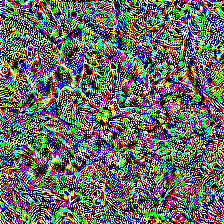I have created a simple CPPN model and the goal is to make learn to create outputs that will maximize the activations of a chosen layer in Torchvision’s pre-trained VGG-19 model. Example diagram of what I’m trying to do (ignore the channel part):
I have thus far been unable to get the CPPN model to learn the right information, and it seems to just create swirling shapes.
The code for training the CPPN model can be found below:
import torch
import torch.nn as nn
import torch.optim as optim
import torchvision.transforms as transforms
from torchvision import models
# Function to maximize CNN activations
def dream_cppn(net, image_size, iterations, lr, use_device):
# Create instance of CPPN
img_cppn = CPPN_Conv(size=image_size, num_channels=24, num_layers=8, use_device=use_device)
print('CPPN Params Count', sum(p.numel() for p in img_cppn.parameters() if p.requires_grad))
# Setup optimizer to optimize CPPN instance
optimizer = torch.optim.Adam(list(img_cppn.parameters()), lr=lr)
# Training loop
for i in range(iterations):
optimizer.zero_grad()
img = img_cppn() # Create RGB image with CPPN
out = net(img) # Get activations from CNN
loss = -out.pow(2).sum().sqrt()
loss.backward()
# Uncomment to save iterations
#simple_deprocess(img.detach(), 'out_'+str(i)+'.png')
print('Iteration', str(i+1), 'Loss', str(loss.item()))
optimizer.step()
return img
# Activation function for CPPN
class CompositeActivation(nn.Module):
def forward(self, input):
input = torch.atan(input)
return torch.cat([input / 0.67, (input * input) / 0.6], 1)
# Compositional pattern-producing network (CPPN) with Conv2d layers
class CPPN_Conv(nn.Module):
def __init__(self, size=(405, 512), num_channels=24, num_layers=8, activ_func=CompositeActivation(), use_device='cpu'):
super(CPPN_Conv, self).__init__()
self.input_size = size
self.n_channels = num_channels
self.net = self.create_net(num_channels, num_layers, activ_func, use_device)
self.cppn_input = self.create_input(use_device)
# Create CPPN (X,Y) --> (R,G,B)
def create_net(self, num_channels, num_layers, activ_func, use_device, bias=True, instance_norm=True, affine=False):
net = nn.Sequential()
net.add_module(str(len(net)), nn.Conv2d(in_channels=2, out_channels=num_channels, kernel_size=1, bias=bias))
if instance_norm:
net.add_module(str(len(net)), nn.InstanceNorm2d(num_channels, affine=affine))
net.add_module(str(len(net)), activ_func)
for l in range(num_layers - 1):
net.add_module(str(len(net)), nn.Conv2d(in_channels=num_channels*2, out_channels=num_channels, kernel_size=1, bias=bias))
if instance_norm:
net.add_module(str(len(net)), nn.InstanceNorm2d(num_channels, affine=affine))
net.add_module(str(len(net)), activ_func)
net.add_module(str(len(net)), nn.Conv2d(in_channels=num_channels*2, out_channels=3, kernel_size=1, bias=bias))
net.add_module(str(len(net)), nn.Sigmoid())
net.apply(self.cppn_normal)
return net.to(use_device)
# Create X,Y input for CPPN
def create_input(self, use_device):
if type(self.input_size) is not tuple and type(self.input_size) is not list:
self.input_size = (self.input_size, self.input_size)
w = torch.arange(0, self.input_size[1]).to(use_device)
h = torch.arange(0, self.input_size[0]).to(use_device)
w_exp = w.unsqueeze(1).expand((self.input_size[1], self.input_size[0])).true_divide(self.input_size[0]) - 0.5
h_exp = h.unsqueeze(0).expand((self.input_size[1], self.input_size[0])).true_divide(self.input_size[1]) - 0.5
return torch.stack((w_exp, h_exp), -1).permute(2,1,0).unsqueeze(0)
# Normalize Conv2d weights
def cppn_normal(self, l):
if type(l) == nn.Conv2d:
l.weight.data.normal_(0, (1.0/self.n_channels)**(1/2))
def forward(self):
return self.net(self.cppn_input)
# Simple deprocess and save image
def simple_deprocess(output_tensor, name):
output_tensor = output_tensor.squeeze(0).cpu().clamp_(0, 1)
Image2PIL = transforms.ToPILImage()
image = Image2PIL(output_tensor.cpu()).save(name)
# Main function to setup params and run code
def main():
image_size=(512,512)
iterations = 50
lr = 0.1
use_device = 'cuda:0'
dream_layer = 37
# Uncomment if loading model from file
#cnn = models.vgg19(pretrained=False)
#cnn.load_state_dict(torch.load('vgg19-dcbb9e9d.pth'))
cnn = models.vgg19(pretrained=True)
layers = list(cnn.features.children())
net = nn.Sequential(*layers[: (dream_layer + 1)]).to(use_device) # Remove layers above target layer
output_tensor = dream_cppn(net, image_size, iterations, lr, use_device)
simple_deprocess(output_tensor, 'out.png')
main()
I am attempting to replicate some seemingly simple results from here: Differentiable Image Parameterizations, but you shouldn’t need to read the article to understand the code. The original results were created using TensorFlow, but I’ve recreated everything in PyTorch, and my CPPN model has the same number of parameters as theirs.
Any help with getting this to work properly would be appreciated! I can answer any questions about the code, but I don’t exactly what I’ve done wrong?




